We’ve spent years covering the Lucy Letby case – here’s why experts are still arguing about it
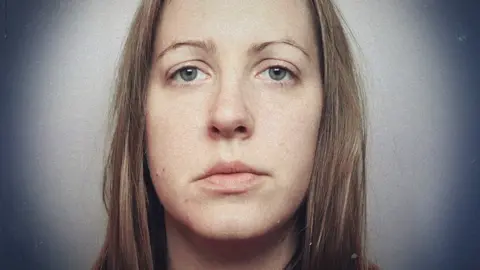 BBCThere are two parallel universes in the Lucy Letby story.
BBCThere are two parallel universes in the Lucy Letby story.
One can be witnessed every day in Liverpool at the public inquiry into her case. Here, the matter of Letby’s guilt is settled. The question for the judge is why Letby was able to harm babies for so long.
In the other universe, doubts about the evidence used to convict her have been mounting. Leading statisticians and medical experts are arguing Letby may be the victim of a miscarriage of justice.
It is a surreal state of affairs: a legal system that has decided Letby is a serial killer – and a debate outside that questions her guilt.
As journalists we have been covering the Lucy Letby case for years – through two trials, an appeals process, an ongoing public inquiry and the growing controversy over her conviction. We have written a book together and made two Panorama films about the case – the latest of which airs on Monday with new information, and hears from both leading critics and the prosecution experts now under fire.
Letby is officially the most prolific child killer of modern times – convicted of murdering seven babies and attempting to murder seven others. And yet her case divides opinion.
Had someone actually seen her harming a baby at the neonatal unit in the Countess of Chester Hospital, the case might have been more straightforward, but no-one did. There was no incriminating CCTV or DNA evidence either. The evidence against her was circumstantial.
The statisticsOne of the documents that played a key role in her trial was a grid, listing the incidents in the case with 'X's to show which members of staff had been on duty. Letby was the only nurse on duty for all of them.
But the grid has attracted scorn from statisticians. They argue that we don’t know how the “suspicious events” listed on the grid were selected or which incidents were excluded, so on its own the grid is little more than a visual stunt. The jury also heard there were two suspicious incidents when Letby was not at work – neither of which was included on the grid.
But is the grid really the problem?
If there was undisputed medical evidence that 24 crimes had been committed, then surely the fact Lucy Letby was present each time would be damning.
And therein lies the key question of the Letby case: How convincing is the medical evidence that the baby deaths and collapses were definitely crimes rather than naturally occurring events?
The air embolism evidenceThe most controversial evidence concerned allegations that Letby murdered babies by injecting air into their blood. That would cause an air embolism – a blockage caused by an air bubble in the blood circulation.
To do this, Letby would have to have taken a syringe and injected the air into the babies’ intravenous lines. These are normally used to administer fluids, drugs, and nutrition to ill or premature newborns.
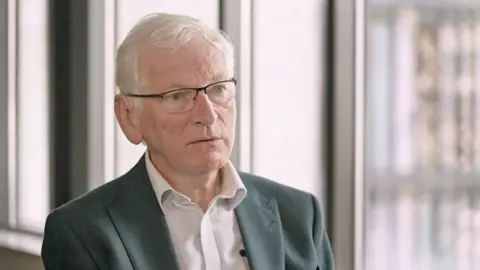 "Babies don't suddenly drop dead," Dr Dewi Evans, expert witness for the prosecution, told PanoramaSyringes in hospitals are thrown away and incinerated after they have been used. As a murder weapon, they are virtually untraceable.
"Babies don't suddenly drop dead," Dr Dewi Evans, expert witness for the prosecution, told PanoramaSyringes in hospitals are thrown away and incinerated after they have been used. As a murder weapon, they are virtually untraceable.
The problem is no-one saw Letby doing this. The allegation rested instead on a “checklist” of observations of some of the babies who died or collapsed while Letby was around.
According to the prosecution, the babies deteriorated suddenly and unexpectedly. Retired consultant paediatrician Dr Dewi Evans was the prosecution's main medical expert witness. He told us: “Babies don't suddenly drop dead.”
Many exhibited strange skin discolourations that medics on the unit hadn’t seen before. Some babies screamed.
The babies also failed to respond to resuscitation as medics expected. Post-mortem X-rays revealed air in the blood vessels of some.
According to the prosecution, this checklist was a sure way to identify air embolism. But how robust was it? Research on air embolism in babies is very limited – something the prosecution’s own experts readily admitted.
One of the most comprehensive studies was a 1989 research paper by two Canadian academics. The account in the paper appeared to support the prosecution case – particularly its references to skin colour changes associated with air embolism.
But the number of cases in the study was limited – just 53 – and the circumstances of the babies described in the paper differed in some respects from those in the Letby case.
 Lucy Letby: Unanswered Questions
Lucy Letby: Unanswered Questions
Reporter Judith Moritz, who has covered the case from the start, investigates the questions that have been raised about Lucy Letby’s conviction.
Watch on BBC iPlayer from 06:00 on Monday 21 October – or on BBC One at 20:00 (20:30 in Wales and Northern Ireland).
One of the paper’s authors, Dr Shoo Lee, later appeared as a witness in Letby’s defence, during her unsuccessful attempt to appeal her convictions in April 2024. He said none of the skin discolourations seen on the babies in the Letby case were proof of air embolism.
Lawyers for the prosecution disagreed. They also pointed out that skin discolouration was just one item on their air embolism checklist and that they had never argued that one particular form of skin discolouration was, on its own, proof of air embolism.
Several experts have publicly criticised the prosecution’s air embolism theory, although hardly any have seen all of the medical evidence. One expert who has is the man who advised Letby's defence during her original ten-month trial: retired consultant neonatologist Dr Mike Hall. Dr Hall didn’t actually give evidence in court, but he told us that in his view there was no proof that the air seen in the X-rays of the babies got there while they were alive.
These are the types of expert disputes now playing out over the medical evidence in the Letby case – and some of them have become personal.
Was the jury misled?Dr Hall believes there were significant flaws in the prosecution’s medical evidence.
He also believes the prosecution experts overstated how stable the babies were before they collapsed and died.
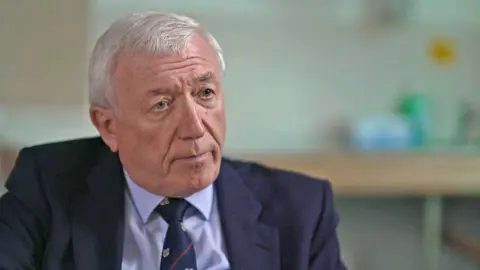 "I think what the prosecution experts said was misleading for the jury," says retired consultant neonatologist Mike Hall“Phrases such as the baby was really, really well were given by the prosecution expert witnesses on several occasions for several of the babies,” Dr Hall told us.
"I think what the prosecution experts said was misleading for the jury," says retired consultant neonatologist Mike Hall“Phrases such as the baby was really, really well were given by the prosecution expert witnesses on several occasions for several of the babies,” Dr Hall told us.
“And it was my view and is my view that they weren't really, really well, they had signs of significant illness.
“I think that what the prosecution experts said was misleading for the jury. That’s not the same thing as saying that they deliberately misled the jury.”
It is an allegation that both of the main prosecution experts reject emphatically.
Dr Dewi Evans told us: “Those suggestions are completely flawed and indicate either that the people making them have not seen the clinical evidence or that they are unaware of what constitutes well-being in a premature baby.”
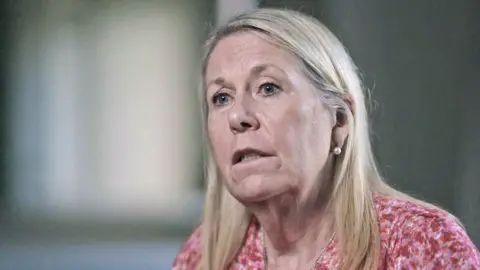 Dr Sandie Bohin, expert witness for the prosecution, says the babies in the case were stable prior to their collapseConsultant paediatrician Dr Sandie Bohin, the prosecution's other main expert, who is speaking about the controversy surrounding the case for the first time, said: “I gave evidence under oath 16 times. I told the truth.”
Dr Sandie Bohin, expert witness for the prosecution, says the babies in the case were stable prior to their collapseConsultant paediatrician Dr Sandie Bohin, the prosecution's other main expert, who is speaking about the controversy surrounding the case for the first time, said: “I gave evidence under oath 16 times. I told the truth.”
“It was my opinion and remains my opinion that these babies were stable prior to their collapse, so I can’t agree with those people that suggested that I misrepresented the stability of the babies and that I misled the jury.
“I think that’s an outrageous suggestion.”
It is an indication of the toxicity and intense division of opinion in the Letby case – even among the experts.
One obvious question is why Dr Hall didn’t testify in court. He clearly disagreed with the prosecution experts, and the fact that he didn’t give evidence meant that Letby had no medical expert witnesses in her defence.
That has prompted some to argue she didn’t have a fair trial.
We asked Dr Hall if he had been willing to testify and he said he had.
He told us he was expecting to give evidence and that he was told of the decision not to call him “right at the last minute”- a decision that left him “at odds” with Letby’s defence team. Dr Hall told us he was so concerned that he even considered writing to the judge to say he believed that the jury had not heard the whole truth.
But the ultimate decision not to call Dr Hall as a witness came from Letby herself – a point that Dr Hall acknowledges.
Why did she not call him? It is one of many questions that only she can answer.
The insulin casesLetby was convicted of using a variety of methods to harm and murder babies – injecting air into their stomachs, force-feeding them with milk, dislodging breathing tubes, and inflicting trauma.
As with the allegations of air embolism, the prosecution relied heavily on the opinions of experts to make their case.
But there was one part of the prosecution’s argument that appeared to rest on something more than individual expert opinion: the insulin evidence.
Lab tests indicated that two babies had been poisoned. The basic principle involved in the test was quite straightforward. When the body produces insulin, it also produces another substance called C-peptide, so C-peptide is a reliable marker of naturally produced insulin.
Although C-peptide is produced by the body at the same rate as insulin, it clears much more slowly. So you would typically expect to see five to 10 times more C-peptide than insulin, if the insulin is natural.
Where you find high levels of insulin, but low levels of C-peptide, there is only one obvious conclusion: the insulin is not natural and has instead been administered from the outside.
That is what investigators found in two of the babies in the Letby case. One had extremely high levels of insulin in his blood and a C-peptide level that was so low that it was unmeasurable.
The second baby had an insulin level more than four times higher than the C-peptide level, again indicating it had not been naturally produced.
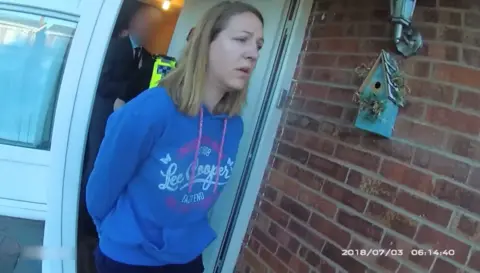 Cheshire ConstabularyPolice body-worn camera footage captured the moment of Lucy Letby's arrestThe medical condition of the babies also fitted with the lab results. In both cases, the babies’ blood sugar levels had plummeted, which is what you would expect to see with insulin poisoning. And while no-one saw Letby poisoning either of the two babies, she was there when they started experiencing symptoms.
Cheshire ConstabularyPolice body-worn camera footage captured the moment of Lucy Letby's arrestThe medical condition of the babies also fitted with the lab results. In both cases, the babies’ blood sugar levels had plummeted, which is what you would expect to see with insulin poisoning. And while no-one saw Letby poisoning either of the two babies, she was there when they started experiencing symptoms.
Of all the allegations in the case, this one looked like the most solid. In court, Letby herself accepted the scientific evidence that the babies had been given dangerous quantities of insulin. She just denied being responsible. Her lawyers were more cautious. They did not accept the insulin evidence, but they did not say it was incorrect either.
For the prosecution, the insulin evidence was fundamental to the entire case. It seemed to prove that someone on the neonatal unit at the Countess of Chester Hospital was a poisoner.
If jurors could be persuaded on this point, it wouldn’t be so difficult for them to conclude that Letby was the culprit.
And so they did. Of all the allegations in the case, the jury returned unanimous verdicts of guilt on just three – and two of these were the insulin cases.
However, since then, sceptics have questioned whether the lab test used to measure insulin and C-peptide in the Letby case was as robust as the prosecution had claimed. It is called an immunoassay test, and works by using antibodies to detect and measure substances.
Critics argue there are circumstances in which the test can mistake another substance for insulin. It is called interference and it could result in a false positive. The critics say the only way to be sure that the substance being measured is indeed insulin is to use a more precise method of analysis – such as mass spectrometry.
We spent months examining this argument. Our conclusion, having spoken to leading experts on all sides of this debate, is that, while the immunoassay method is not perfect, it is usually accurate and the circumstances in which interference might occur are extremely unlikely in the context of the babies in the Letby case.
It is even more unlikely that two lab tests conducted within months of each other would both be wrong.
In this week’s Panorama, we reveal new evidence on the insulin allegations and the question of whether Lucy Letby really poisoned babies.
The big pictureAn enduring challenge in the Letby case – and reporting on it – is the difficulty of seeing the big picture.
Individual parts of the evidence can, and will continue to be, criticised. But it is not possible to reach a view on the case without taking all of the evidence into account – and some of this goes beyond the opinions of the medical experts.
Letby’s time in the witness box was revealing for those who were there. During her original trial, she spent 14 days being questioned. Several observers noted that she seemed aloof and indifferent. At times, she squirmed, and seemed to tie herself in knots.
She claimed she could not remember things – like the death of a baby she had texted colleagues about, or searching repeatedly for the parents of dead babies online.
There are other details, not included in Letby’s trials, that are also challenging for the sceptics.
A total of 13 babies died in the neonatal unit between June 2015 and June 2016. Letby was on duty for 12 of them.
And yet, no-one actually saw her harm a baby.
In recent weeks, several of Letby’s colleagues have given evidence to the Thirlwall Inquiry saying that they have since come to realise her guilt.
However, when consultants began to suspect her back in 2016, many of her nursing colleagues remained fiercely loyal – and they remained loyal even after her removal from the neonatal unit in July 2016.
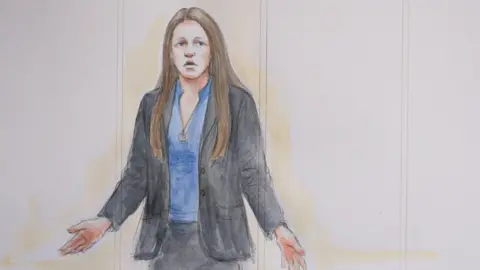 Helen TipperA court artist captured the moment Letby said to the judge after her second trial: "I'm innocent"It’s not hard to understand why. There is nothing obvious in Letby’s background that points to her becoming a killer. Her parents seem to have adored her, and her friendship groups in Hereford – and later in Chester – were happy and supportive. Her closest friends in Hereford remain convinced she is innocent.
Helen TipperA court artist captured the moment Letby said to the judge after her second trial: "I'm innocent"It’s not hard to understand why. There is nothing obvious in Letby’s background that points to her becoming a killer. Her parents seem to have adored her, and her friendship groups in Hereford – and later in Chester – were happy and supportive. Her closest friends in Hereford remain convinced she is innocent.
Then there is Letby’s own continued protestation of innocence. In July 2024, she was convicted of a further count of attempted murder. After hearing the verdict, before being taken to the cells, she turned to the judge with outstretched palms and said: “I’m innocent.”
Letby now has a new lawyer, Mark McDonald, who plans to take her case to the Criminal Cases Review Commission (CCRC). Her attempts to appeal against her convictions have so far failed.
Mr McDonald tells us he has gathered the finest experts in the world to review the prosecution’s medical and scientific evidence. He says the prosecution’s case was flawed and he is confident his team of experts will give him the arguments he needs to challenge her convictions.
But the CCRC process could take years. In the meantime, battles over the evidence will continue. That means more heartbreak for the families of the babies, who say they find the continual questioning of Lucy Letby’s convictions “grossly offensive and distressing”.

 Getty ImagesKemi Badenoch (L) and Robert Jenrick (R)The shock at the elimination of James Cleverly was near universal.
Getty ImagesKemi Badenoch (L) and Robert Jenrick (R)The shock at the elimination of James Cleverly was near universal. Business UBA’s Summer Delight for Customers 00:17, 2nd Aug, 2023 by Nume Ekeghe
Business UBA’s Summer Delight for Customers 00:17, 2nd Aug, 2023 by Nume Ekeghe  Business TTSWG Affirms Commitment to Building Sustainable Technology Ecosystem 00:16, 2nd Aug, 2023 by editor
Business TTSWG Affirms Commitment to Building Sustainable Technology Ecosystem 00:16, 2nd Aug, 2023 by editor  Business Addressing Disincentive Clauses in Pension Laws 00:15, 2nd Aug, 2023 by Ebere Nwoji
Business Addressing Disincentive Clauses in Pension Laws 00:15, 2nd Aug, 2023 by Ebere Nwoji  Business Sterling Bank, LASHMA Expand Healthcare In Lagos 00:11, 2nd Aug, 2023 by Nume Ekeghe
Business Sterling Bank, LASHMA Expand Healthcare In Lagos 00:11, 2nd Aug, 2023 by Nume Ekeghe  Business Eterna Reports 21.2% Increase in Revenue to N69.34bn 00:11, 2nd Aug, 2023 by Kayode Tokede
Business Eterna Reports 21.2% Increase in Revenue to N69.34bn 00:11, 2nd Aug, 2023 by Kayode Tokede  Business USAID, Winrock Partner FCAHPT on Sustainable Agriculture 00:11, 2nd Aug, 2023 by Seriki Adinoyi Deriving Value from an Effective Pay Structure NIMASA Confirms Hijack of Vessel, Pledges Speedy Passage of Anti-piracy Bill Binatone Launches New Kitchen Machine in Nigeria Danbatta: Why FG Can’t Achieve 30% National Broadband Target by 2018 GTBank, Ijaiye Road, Ogba, Lagos TECNO’s New UI, HiOS: Hi Fonts on the HiOS Replaced the iFont Emirates Extends Online Check-in to 48 Hours FG to Commence Prosecution of Companies for Non-Implementaion of Compensation Scheme Seaman’s Schnapps Revamps 40 Hand Pump Boreholes in Four States Tracking Buhari’s Economic Policy Direction IMF Executive Board 2016 Article IV Consultation with Nigeria Shade Okoya: Outside Work, I Hang out with My Husband and Children Global Oil Crisis, Harsh Macro-Economic Environment Put Banking Sector in Dire Straits Non-oil Export Sector Receives Boost as NEPC, LBS, Bank Collaborate Dufil’s Commitment to Nutritional Standard Wakanow: Taking African Destinations Global Marriot Sole Bidder for Starwood Hotels as Chinese-led Consortium Withdraws Offer Auto Policy, Forex Take Toll on Vehicle Importation, Present Opportunities for Local Production Dubai to Introduce Airport Tax Konga Launches Same Day Delivery Tecno Goes Swag with HiOS Operators Battle FAAN over Excessive Charges MAN Tasks Biosafety Agency, Monsanto on Release of GM Cotton Adeleke Chides Petroleum Products Dealers Microsoft’s Restates Commitment to ICT Market CONSAT Launches ‘Yoruba Swaga’ 2016 Budget: As Contractors Set to Return to Sites Nigeria: History, Appeasement and Failure Glo’s TVC Takes Subscribers on Tour of Rich Data Bundles Promasidor Cowbellpedia Maths Qualifying Exam Records Impressive Turn-Out Nigerian Banks Ripoff Customers TBI Brings Royal Caribbean to Nigeria Toyota Prius is Prime Reveal at 2016 New York Auto Show, Says Bill Fay Peugeot Displays Vehicles Assembled in Nigeria at Enugu Trade Fair Michelin Rewards Dealers Mobil, Michelin, Insurance Coys, Others Head to Lagos Motor Fair Kewalram Chanrai Group Launches First Truck Assembled in Nigeria Barbedos Unveils Mercedes-Maybach S-Class BMW Plotting Ultra-Luxury X7 Worth $100K Features of 2017 Nissan GT-R NISMO Ntel Unveils Rollout Plan, Begins Commercial Sales of 0804 Lines April 8 Four Foreign Companies Scrambling for Bakassi Deep Seaport, Says Ayade Brussels Airport Attacks as an Eye Opener Ex-FAAN MD: Why FG Should Privatise 22 Airports Truck Owners Fault ANLCA’s Position on NPA Policy Julius Berger Nigeria’s Profit Dips 70% on Lull in Construction Sector Bean Growers, Stakeholders Want Ban Lifted Former LCCI President Hails NCS on Importation Policy Small-scale Farmers Face Difficulty in Accessing Agricultural policies
Business USAID, Winrock Partner FCAHPT on Sustainable Agriculture 00:11, 2nd Aug, 2023 by Seriki Adinoyi Deriving Value from an Effective Pay Structure NIMASA Confirms Hijack of Vessel, Pledges Speedy Passage of Anti-piracy Bill Binatone Launches New Kitchen Machine in Nigeria Danbatta: Why FG Can’t Achieve 30% National Broadband Target by 2018 GTBank, Ijaiye Road, Ogba, Lagos TECNO’s New UI, HiOS: Hi Fonts on the HiOS Replaced the iFont Emirates Extends Online Check-in to 48 Hours FG to Commence Prosecution of Companies for Non-Implementaion of Compensation Scheme Seaman’s Schnapps Revamps 40 Hand Pump Boreholes in Four States Tracking Buhari’s Economic Policy Direction IMF Executive Board 2016 Article IV Consultation with Nigeria Shade Okoya: Outside Work, I Hang out with My Husband and Children Global Oil Crisis, Harsh Macro-Economic Environment Put Banking Sector in Dire Straits Non-oil Export Sector Receives Boost as NEPC, LBS, Bank Collaborate Dufil’s Commitment to Nutritional Standard Wakanow: Taking African Destinations Global Marriot Sole Bidder for Starwood Hotels as Chinese-led Consortium Withdraws Offer Auto Policy, Forex Take Toll on Vehicle Importation, Present Opportunities for Local Production Dubai to Introduce Airport Tax Konga Launches Same Day Delivery Tecno Goes Swag with HiOS Operators Battle FAAN over Excessive Charges MAN Tasks Biosafety Agency, Monsanto on Release of GM Cotton Adeleke Chides Petroleum Products Dealers Microsoft’s Restates Commitment to ICT Market CONSAT Launches ‘Yoruba Swaga’ 2016 Budget: As Contractors Set to Return to Sites Nigeria: History, Appeasement and Failure Glo’s TVC Takes Subscribers on Tour of Rich Data Bundles Promasidor Cowbellpedia Maths Qualifying Exam Records Impressive Turn-Out Nigerian Banks Ripoff Customers TBI Brings Royal Caribbean to Nigeria Toyota Prius is Prime Reveal at 2016 New York Auto Show, Says Bill Fay Peugeot Displays Vehicles Assembled in Nigeria at Enugu Trade Fair Michelin Rewards Dealers Mobil, Michelin, Insurance Coys, Others Head to Lagos Motor Fair Kewalram Chanrai Group Launches First Truck Assembled in Nigeria Barbedos Unveils Mercedes-Maybach S-Class BMW Plotting Ultra-Luxury X7 Worth $100K Features of 2017 Nissan GT-R NISMO Ntel Unveils Rollout Plan, Begins Commercial Sales of 0804 Lines April 8 Four Foreign Companies Scrambling for Bakassi Deep Seaport, Says Ayade Brussels Airport Attacks as an Eye Opener Ex-FAAN MD: Why FG Should Privatise 22 Airports Truck Owners Fault ANLCA’s Position on NPA Policy Julius Berger Nigeria’s Profit Dips 70% on Lull in Construction Sector Bean Growers, Stakeholders Want Ban Lifted Former LCCI President Hails NCS on Importation Policy Small-scale Farmers Face Difficulty in Accessing Agricultural policies  Doyin Salami’s Elitism Versus Muhammadu Buhari’s Populism « Previous1…1,0381,0391,040
Doyin Salami’s Elitism Versus Muhammadu Buhari’s Populism « Previous1…1,0381,0391,040